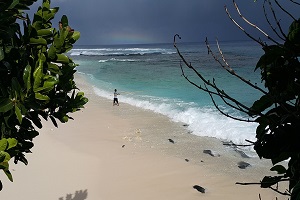-
Home
-
Data & Publications
-
Regional Portals
- About Regional Portals
- Florida
- Navassa Island
- Puerto Rico
- Flower Garden Banks
- U.S. Virgin Islands
- American Samoa
- Commonwealth of the Northern Mariana Islands
- Federated States of Micronesia
- Guam
- Main Hawaiian Islands
- Republic of the Marshall Islands
- Northwestern Hawaiian Islands
- Republic of Palau
- Pacific Remote Island Areas
-
CRCP Activities
- Glossary
National Coral Reef Monitoring Program:
Understanding Socioeconomic Connections

The Socioeconomic Component of the National Coral Reef Monitoring Program (NCRMP) collects and monitors socioeconomic information, including human use of coral reef resources, knowledge, attitudes, and perceptions of coral reefs and coral reef management, and demographics of the populations living in coral reef areas. The overall goal of the socioeconomic monitoring component is to track relevant information regarding each jurisdiction's population, social and economic structure, the benefits of coral reefs and related habitats, the perceived impacts of society on coral reefs, and the impacts of coral management on communities. NOAA's Coral Reef Conservation Program (CRCP) uses the information to improve programs designed to protect coral reefs at local, regional, and national levels, as well as to inform continuing research and communication products.
Background
In 2007, the NOAA CRCP underwent an external review by an expert panel to provide an independent assessment of CRCP's effectiveness in meeting its mandates and to suggest recommendations for improvement. One of the key recommendations of this review was to increase CRCP's social science portfolio by engaging local communities and better assessing the social and economic consequences of management policies, interventions, and activities on those communities. The main purpose of the Socioeconomic Component of NCRMP is to answer the following questions: What is the status of human knowledge, attitudes, and perceptions regarding coral reefs? And, how are human uses of, interactions with, and dependence on coral reefs changing over time?
Approach
The NCRMP socioeconomic indicators were developed through an iterative process. These 13 indicators provide information that assists CRCP in answering the questions above.
Two streams of data are integrated to inform the indicators for each of the seven inhabited US coral reef jurisdictions: South Florida, the US Virgin Islands, Puerto Rico, Hawai’i, American Samoa, Guam, and the Commonwealth of the Northern Mariana Islands (CNMI). First, residents in each coral jurisdiction are surveyed every 5-7 years. Second, additional socioeconomic data are compiled using secondary data sources, such as the US Census Bureau and local government agencies. Jurisdictional findings are then able to support national metrics.
Additional information on the indicators and survey results from each jurisdiction can be found in the links below.
Updates for Active NCRMP Socioeconomic Survey Efforts
- Guam - 2023 Socioeconomic Survey
- Commonwealth of the Northern Mariana Islands - 2024 Socioeconomic Survey
Outreach Products
- Perceptions of U.S. Caribbean coral reef ecosystem services contextualize fishing perceptions of COVID-19 impacts
- FAQs NCRMP Socio-economic Survey
- NCRMP Socio-economic Monitoring Component One Pager
- American Samoa Infographics
- South Florida Infographics
- Puerto Rico Infographics
- Hawai'i Infographics
- Guam Infographics
- Commonwealth of Northern Mariana Islands Infographic
- U.S. Virgin Islands Infographic
Documents
- National Coral Reef Monitoring Program Socioeconomic Monitoring Component
- Summary Findings for Guam, 2023
- Summary Findings for American Samoa, 2021
- Summary Findings for Hawai'i, 2020
- Summary Findings for American Samoa, 2014
- Summary Findings for South Florida, 2014
- Summary Findings for South Florida, 2019
- Summary Findings for Puerto Rico, 2015
- Summary Findings for Puerto Rico, 2022
- Summary Findings for Hawai'i, 2015
- Summary Findings for Guam, 2016
- Summary Findings for CNMI, 2016
- Summary Findings for USVI, 2017
- Article in Water: Resident Perceptions of Ecosystem Services Provided by U.S. Coral Reefs
- National Coral Reef Monitoring Program: Socioeconomic Indicator Development
- NCRMP Socioeconomic Survey: CORE Questions Template; 2014-2018
- NCRMP Socioeconomic Survey: CORE Questions Template; 2019-2021
- NCRMP Socioeconomic Survey: CORE Questions Template; 2022-present
- Workshop Report, Social and Economic Indicators for Monitoring the U.S. Coral Reef
Jurisdictions
Presentations
- NCRMP Socioeconomic Monitoring for CNMI - May 2019
- NCRMP Socioeconomic Monitoring for USVI - May 5, 2019
- NCRMP Socioeconomic Monitoring for Guam - June 18, 2018
- Presentation NCRMP Socioeconomic Monitoring NOAA Seminar - November 29, 2016
- NCRMP Socioeconomic Monitoring for Puerto Rico - November 7, 2016
- NCRMP Socioeconomic Monitoring for Hawaii - June 16, 2016
- NCRMP Socioeconomic Monitoring for South Florida - June 5, 2015
- NCRMP Socioeconomic Monitoring for South Florida, Cycle 2 - December 1, 2020
- Presentation NCRMP Socio-economic Monitoring - April 9, 2015
- NCRMP Socioeconomic Monitoring for American Samoa
- Presentation NCRMP Socio-economic Monitoring - January 9, 2014
Complete list of publications produced by the NCRMP Socioeconomic Team.
Data
- American Samoa
- Commonwealth of the Northern Marianas Islands
- South Florida
- Guam
- Hawaii
- Puerto Rico
- U.S. Virgin Islands
For more information, contact:


